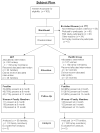Family mechanisms of structural ecosystems therapy for HIV-seropositive women in drug recovery
- PMID: 22708519
- PMCID: PMC3884197
- DOI: 10.1037/a0028672
Family mechanisms of structural ecosystems therapy for HIV-seropositive women in drug recovery
Abstract
Objective: Examined the effects of Structural Ecosystems Therapy (SET), a family intervention for women living with HIV or AIDS, compared to a psycho-educational health group (HG) intervention, and reciprocal relationships between women and family members.
Method: Women (n = 126) and their family members (n = 269) were randomized to one of two conditions and assessed every 4 months for 12 months. Family functioning, drug use, and psychological distress was reported by multiple family members.
Results: Multilevel growth curve modeling showed a different family functioning trajectory between SET and HG, B = -0.05, SE = 0.02, p < .01. There was no intervention effect on the trajectory of family-level drug abstinence or psychological distress, but there was a significant difference in the trajectory of psychological distress after controlling for change in family functioning, B = -0.28, SE = 0.13, p < .05. There was an indirect effect from treatment through change in family functioning to change in psychological distress, B = 0.29, SE = 0.12, p < .05. With respect to reciprocal effects, family drug abstinence significantly predicted women's abstinence 4 months later, B = 0.22, SE = 0.06, p < .001.
Conclusion: Findings demonstrated the interdependence of family members and the impact of family in relapse prevention and partially supported SET's potential for maintaining family functioning and well-being for women living with HIV or AIDS in drug recovery.
PsycINFO Database Record (c) 2012 APA, all rights reserved.
Figures



References
-
- Baker SA, Beadnell B, Stoner S, Morrison DM, Gordon J, Collier C, Stielstra S. Skills training versus health education to prevent STDs/HIV in heterosexual women: A randomized controlled trial utilizing biological outcomes. AIDS Education and Prevention. 2003;15:1–14. doi: 10.1521/aeap.15.1.1.23845. - DOI - PubMed
-
- Campo R. Questions for an epidemic. The New England Journal of Medicine. 2004;350:968–970. - PubMed

